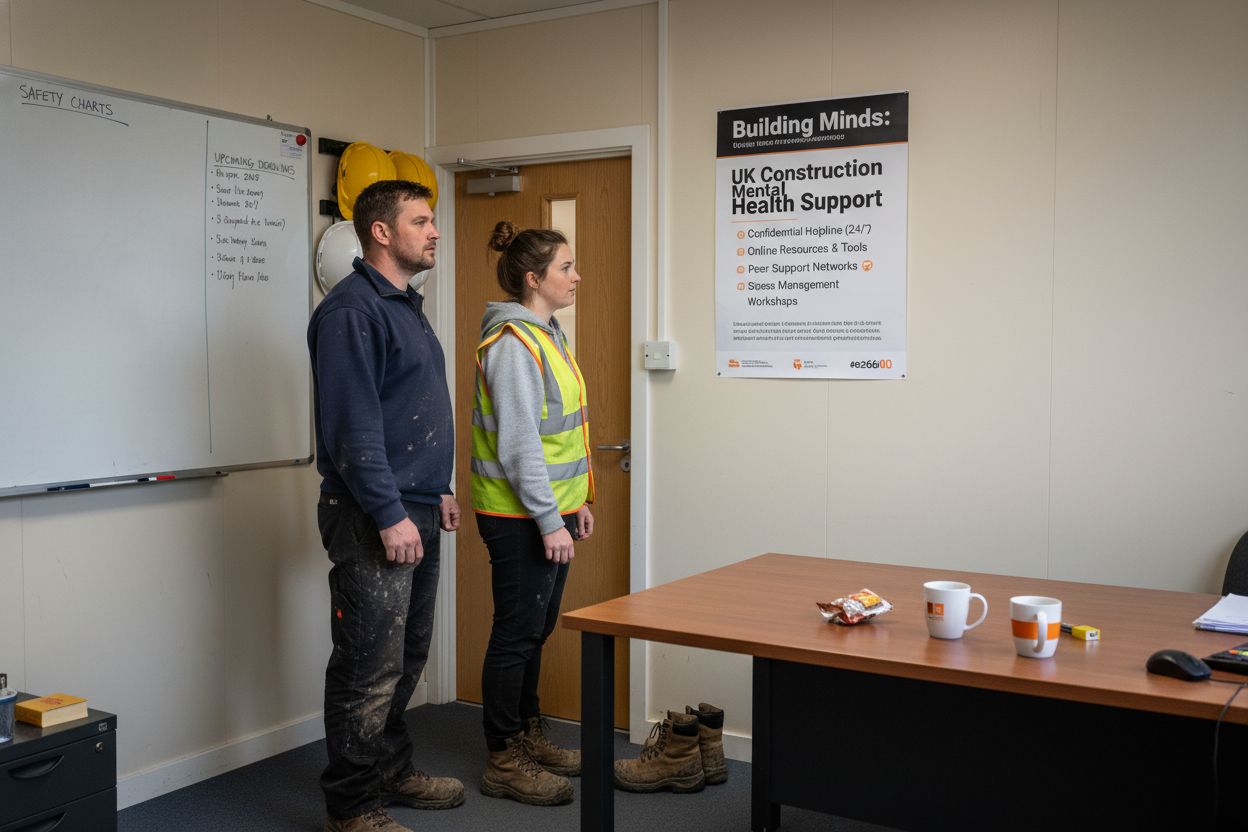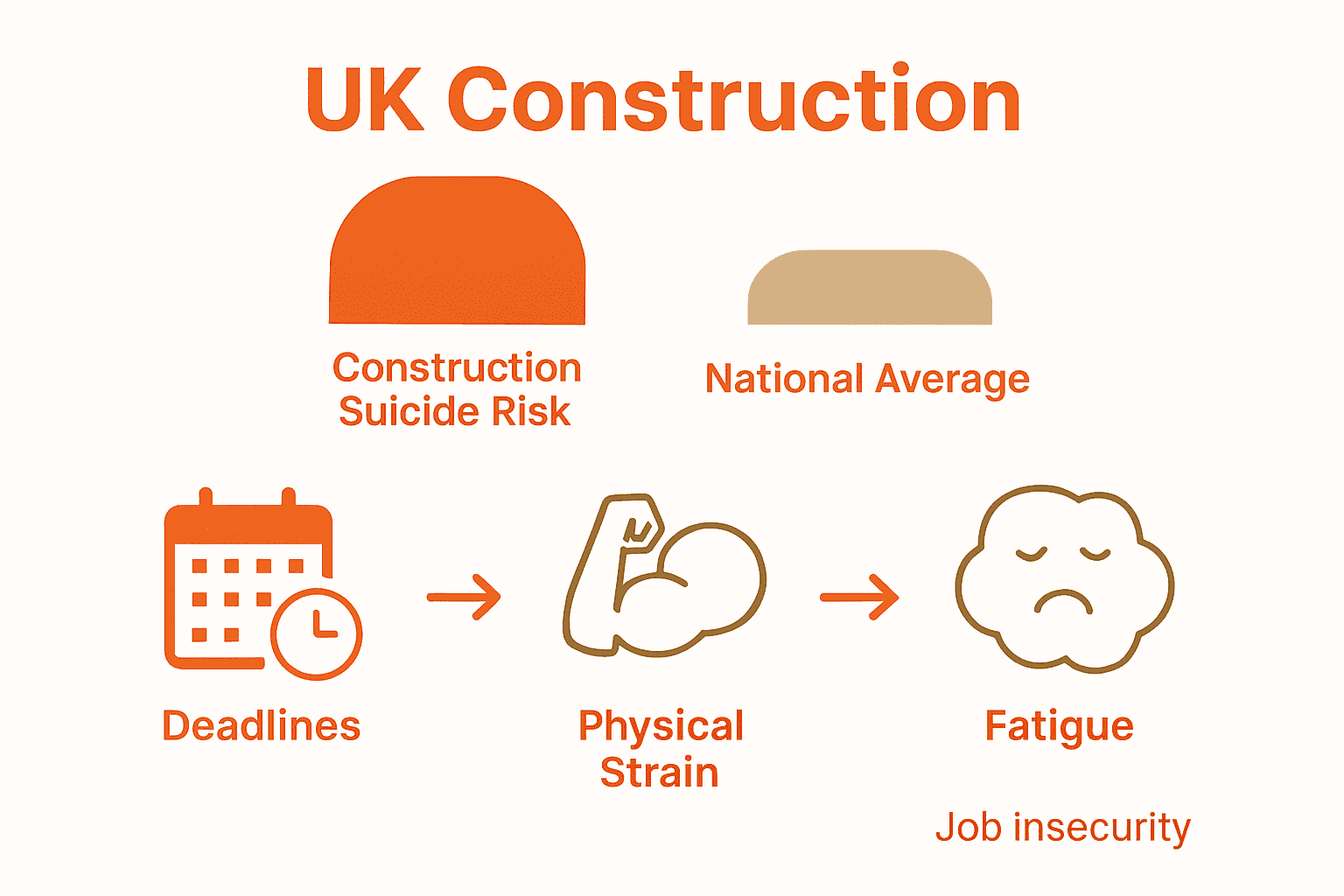Shockingly, construction workers face suicide rates that are four times higher than the national average in the UK. This crisis stretches far beyond individual struggles, shaping the safety and culture of every jobsite. Pressure, stigma, and harsh working conditions combine to challenge mental wellbeing throughout the industry. By understanding the facts and risk factors, we can begin to address these urgent issues and pave the way for healthier, more productive workplaces.
Key Takeaways
| Point | Details |
|---|---|
| Mental Health Importance | Mental health is critical in construction, significantly impacting safety and worker performance. Immediate comprehensive support is needed to address the alarming statistics. |
| Systemic Challenges | Factors like job insecurity, long hours, and cultural stigma create significant mental health challenges. Awareness and collective intervention are essential for a supportive workplace culture. |
| Legal Responsibilities | UK regulations require employers to address mental health proactively. This includes risk assessments and supportive mechanisms, extending care beyond physical safety. |
| Best Practices | Comprehensive, innovative support initiatives like the Mates in Mind programme improve workplace mental health. Cultivating an open culture and reducing stigma are key for effective support. |
Table of Contents
- Defining Mental Health In Construction
- Common Mental Health Challenges On-Site
- Key Risk Factors And Workplace Stressors
- Legal Responsibilities And UK Regulations
- Best Practices For Supporting Workers
Defining Mental Health in Construction
Mental health in construction isn’t just about feeling good—it’s a critical workplace safety and human performance issue. Mental health refers to an individual’s psychological and emotional well-being, representing how workers cope with daily stressors, manage challenges, and maintain professional resilience.
The construction industry faces uniquely challenging mental health statistics that demand immediate attention. According to the Lighthouse Construction Industry Charity, two UK construction workers take their own lives every working day, while stress, depression, and anxiety account for 27% of all work-related illnesses. These alarming figures highlight the urgent need for comprehensive mental health support.
Research from the University of Derby reveals even more concerning insights about mental health in this sector:
- Male construction workers are four times more likely to die by suicide than the national average
- Approximately 30% have taken time off due to mental health problems
- 60% did not disclose the reason for their absence to their employer
The root causes of poor mental health in construction are multifaceted, including:
- High-pressure work environments
- Physical strain and demanding physical labor
- Job insecurity
- Long working hours
- Cultural stigma around discussing emotional challenges
Understanding mental health as more than just an individual issue, but a systemic challenge requiring collective support and intervention, is crucial for transforming workplace culture and worker well-being.
Common Mental Health Challenges On-Site
Construction workers face a unique set of mental health challenges that are intrinsically linked to the demanding nature of their work environment. These challenges go beyond typical workplace stress, creating complex psychological pressures that can significantly impact worker wellbeing and performance.
The primary mental health challenges on construction sites typically include:
- Chronic Stress: Constant pressure from tight deadlines, complex project requirements, and physical demands
- Job Insecurity: Fluctuating work opportunities and contract-based employment creating ongoing uncertainty
- Physical Exhaustion: Intense manual labor leading to mental fatigue and emotional burnout
- Social Isolation: Limited opportunities for meaningful workplace interactions and emotional support
- Stigma: Deep-rooted cultural resistance to discussing mental health concerns openly
Psychological safety is particularly compromised by the industry’s traditional masculine culture, which often discourages emotional vulnerability. Workers frequently feel compelled to maintain a tough exterior, suppressing genuine feelings of anxiety, depression, or overwhelm. This emotional repression can lead to more severe mental health complications if left unaddressed.

Interested in creating a more supportive workplace? Check out our employee wellbeing ideas that can help transform workplace mental health strategies. Understanding these challenges is the first critical step towards developing comprehensive support systems that protect and nurture construction workers’ psychological wellbeing.
Key Risk Factors and Workplace Stressors
The construction industry harbors multiple systemic stressors that significantly impact workers’ mental health, creating a complex web of psychological challenges that extend far beyond typical workplace pressures. Research reveals a multifaceted landscape of risk factors that continuously challenge worker wellbeing.
According to OnWellbeing’s industry insights, several critical workplace stressors emerge as primary contributors to mental health challenges:
- High-pressure project deadlines
- Intense physical strain and demanding manual labor
- Persistent job insecurity
- Extended working hours
- Frequent geographical relocation
- Socially isolating work environments
Most critically, the research highlights that workplace bullying can double the likelihood of suicidal thoughts among construction workers. This stark finding underscores the profound psychological impact of negative workplace interactions.
Research from the University of Derby further emphasizes that poor work-life balance significantly exacerbates mental health challenges. The study revealed that workers struggling with maintaining personal and professional boundaries experienced substantially worse mental health outcomes.
Interestingly, self-compassion emerged as a powerful protective factor, helping workers reduce shame and mitigate the negative psychological impacts of their demanding work environment.
Here’s a summary of key workplace risk factors and their psychological impacts:

| Risk Factor | Typical Impact | Example Symptoms |
|---|---|---|
| High-pressure deadlines | Chronic stress | Anxiety Irritability |
| Physical strain | Fatigue Burnout |
Exhaustion Low motivation |
| Job insecurity | Persistent worry | Sleep problems Restlessness |
| Extended working hours | Poor work-life balance | Overwhelm Withdrawal |
| Social isolation | Loneliness | Low morale Disengagement |
| Workplace bullying | Increased risk of suicidal thoughts | Hopelessness Distress |
| Stigma | Emotional suppression | Reluctance to seek help |
Legal Responsibilities and UK Regulations
In the United Kingdom, legal frameworks surrounding mental health in the workplace have evolved to recognize psychological wellbeing as a critical aspect of employee safety. The cornerstone of these regulations is the Health and Safety at Work etc. Act 1974, which establishes a comprehensive duty of care for employers across all sectors, including construction.
According to Wikipedia’s overview of the Act, employers are legally required to ensure, “as far as reasonably practicable,” the health, safety, and welfare of their employees. This legislative mandate explicitly extends beyond physical safety to encompass mental health, creating a robust legal foundation for workplace psychological support.
Key legal responsibilities for construction employers include:
- Conducting comprehensive risk assessments for psychological hazards
- Implementing mental health support mechanisms
- Providing training on recognizing and managing mental health challenges
- Creating supportive, non-discriminatory work environments
- Offering confidential counseling and support services
The Chartered Institute of Building has taken proactive steps to support these legal requirements by partnering with Anxiety UK to develop a Massive Open Online Course (MOOC) on mental health in construction. This initiative demonstrates the industry’s commitment to understanding mental wellbeing, recognizing symptoms of poor mental health, and fostering supportive workplace cultures.
Navigating these legal responsibilities requires a holistic approach that balances compliance with genuine care for worker psychological safety.
Best Practices for Supporting Workers
Supporting mental health in construction requires a multilayered, proactive approach that goes beyond traditional workplace welfare strategies. Workplace support must be comprehensive, systematic, and deeply integrated into organizational culture to effectively address the unique challenges faced by construction workers.
According to GoConstruct’s industry insights, several innovative initiatives have emerged to transform workplace mental health support:
- Fairness, Inclusion & Respect programme
- ‘Starting the conversation’ scheme to encourage open mental health discussions
- Building Mental Health framework
- Construction Industry Helpline and mobile app
- #MakeItVisible awareness campaign
- Mates in Mind support network
The National Building Specification highlights the Mates in Mind programme as a gold standard for mental health training, offering targeted interventions across organizational levels:
- Senior managers receive two-day comprehensive training
- Site supervisors participate in morning workshop sessions
- Individual workers get focused 45-minute awareness sessions
These programmes are strategically developed in collaboration with Mental Health First Aid England, Mind, and the Samaritans, ensuring professional, evidence-based support. The key is creating a culture of openness, reducing stigma, and providing accessible, judgment-free mental health resources that workers can easily utilize.
Ultimately, effective mental health support transforms from a compliance requirement to a genuine commitment to worker wellbeing, recognizing that psychological safety is as crucial as physical safety in high-stress industries like construction.
Create Safer, More Supportive Workspaces in Construction
Working in construction brings serious mental health pressures, from chronic stress to workplace fatigue and emotional isolation. As discussed in our guide, psychological safety is as vital as physical safety. The right environment can make a real difference for every member of your team. How can you show workers you prioritise wellbeing, starting from the ground up?

Choose premium, anti-slip mats and tailored floor coverings from Mats4U to help make your site safer and more comfortable for everyone. Our customised mat solutions reduce physical hazards and reinforce your overall focus on worker care. When every element of your site supports both mental and physical health, you demonstrate a level of commitment that builds trust and loyalty. Visit the Mats4U homepage today to discover industry-leading products and expert advice. Take a proactive step now towards creating a construction site where both safety and wellbeing are a priority.
Frequently Asked Questions
What are the key mental health challenges faced by construction workers?
Construction workers often face challenges such as chronic stress from tight deadlines, job insecurity, physical exhaustion from manual labor, social isolation, and stigma surrounding mental health discussions.
How can employers support mental health in the construction industry?
Employers can support mental health by conducting risk assessments, implementing mental health support mechanisms, providing training, fostering a supportive work environment, and offering confidential counseling services.
What are common symptoms of poor mental health in construction workers?
Common symptoms include anxiety, irritability, fatigue, low motivation, sleep problems, and feelings of hopelessness and distress. Workers may also experience withdrawal and disengagement from their jobs.
What legal responsibilities do employers have regarding mental health in construction?
Employers are required to ensure the health, safety, and welfare of their employees, which includes conducting risk assessments for psychological hazards, implementing mental health support systems, and creating a non-discriminatory work environment.
Recommended
- 8 Essential Employee Wellbeing Ideas for Every Workplace – Mats4U
- Understanding Creating Safe Learning Environments – Mats4U
- Understanding Sustainable Construction Materials: A Comprehensive Guid – Mats4U
- How to Improve Air Quality for Healthier Workspaces – Mats4U
- 7 Rahsia Keselamatan di Tapak Pembinaan yang Anda Perlu Tahu Sebelum Terlambat! | RumahHQ - Kontraktor Bina & Renovate Rumah









